University Finance Report: Analysis of Stock Returns and Investments
VerifiedAdded on 2022/09/09
|13
|1353
|13
Report
AI Summary
This report provides a comprehensive analysis of stock returns, covering various aspects of financial analysis and investment strategies. The report begins with an examination of future value calculations and required savings, followed by an analysis of investment projects, including NPV and IRR calculations to determine profitability. It then explores the impact of different investment options on financial returns, comparing the performance of investment and super funds. The report also discusses corporate financial strategies, such as cost reduction and the dividend imputation tax system. Furthermore, it delves into loan payment structures, diversification benefits, and portfolio beta calculations, with an emphasis on risk assessment and the application of CAPM. The analysis includes the examination of Qantas stock's performance, including average returns, volatility, and holding period returns. Finally, the report concludes with a discussion of beta's role in risk assessment and the expected return calculation using CAPM, and presents a security market line analysis. All figures and calculations are sourced and presented in the report. The assignment includes a bibliography of the sources used for the analysis.
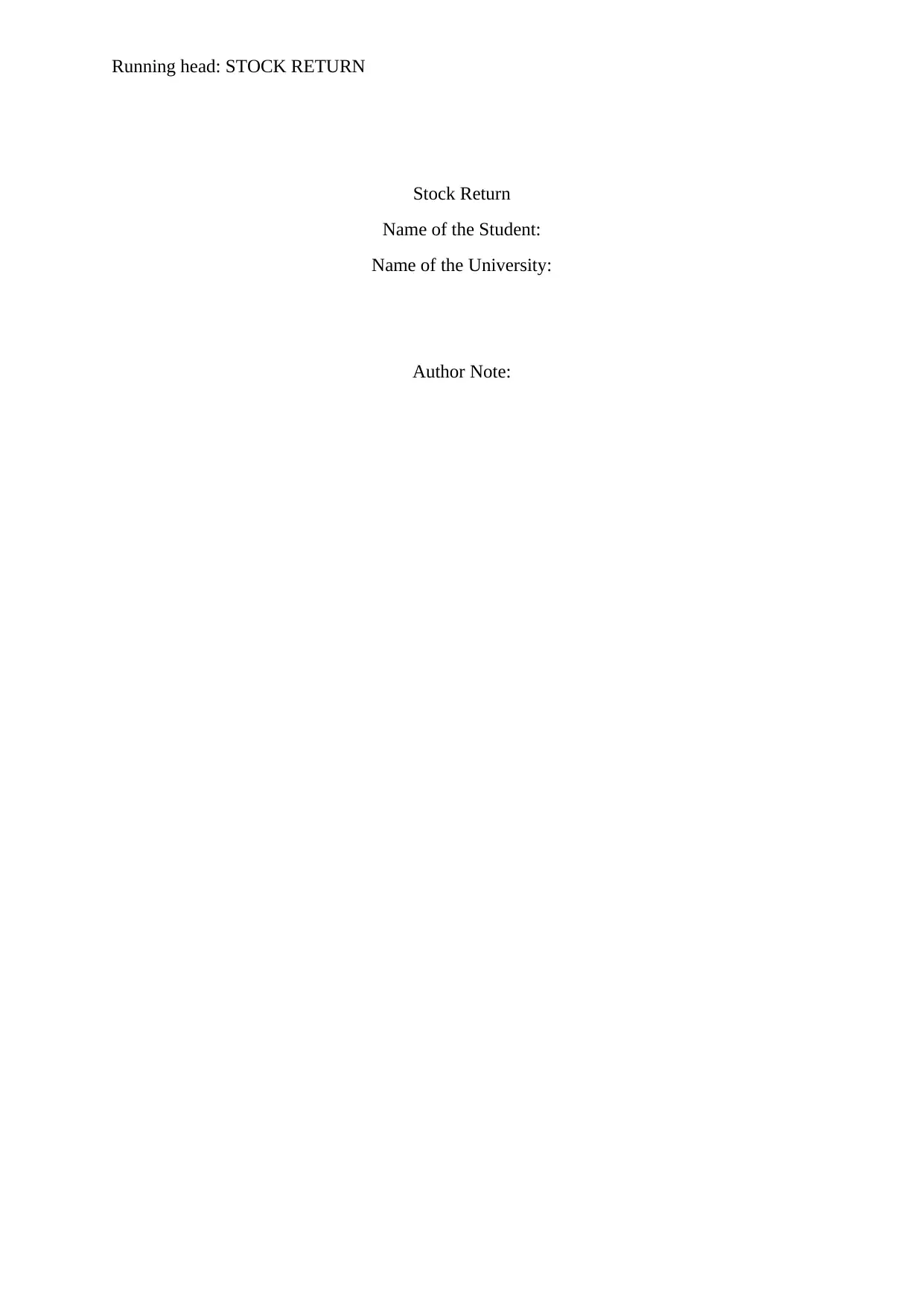
Running head: STOCK RETURN
Stock Return
Name of the Student:
Name of the University:
Author Note:
Stock Return
Name of the Student:
Name of the University:
Author Note:
Paraphrase This Document
Need a fresh take? Get an instant paraphrase of this document with our AI Paraphraser
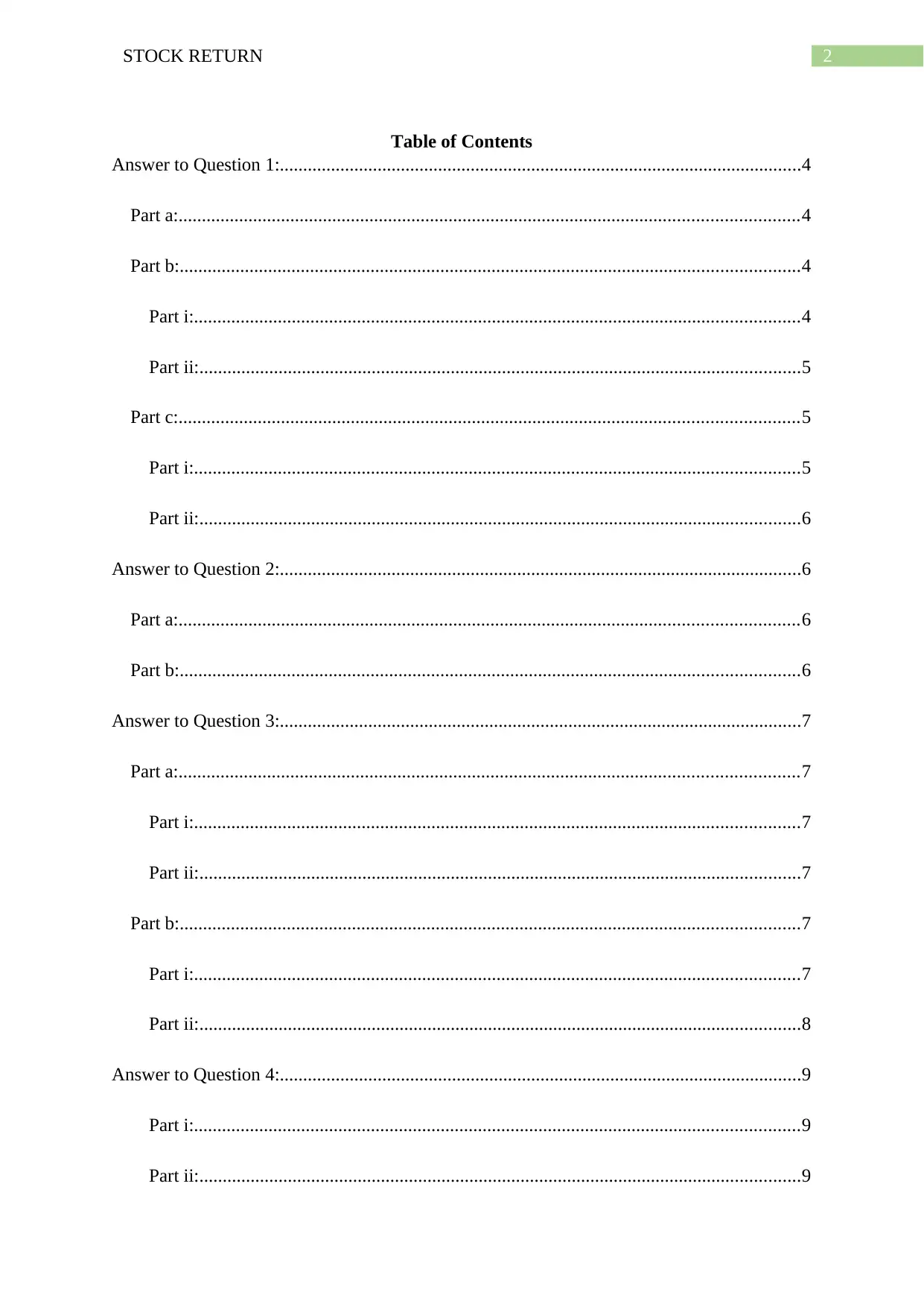
2STOCK RETURN
Table of Contents
Answer to Question 1:................................................................................................................4
Part a:.....................................................................................................................................4
Part b:.....................................................................................................................................4
Part i:..................................................................................................................................4
Part ii:.................................................................................................................................5
Part c:.....................................................................................................................................5
Part i:..................................................................................................................................5
Part ii:.................................................................................................................................6
Answer to Question 2:................................................................................................................6
Part a:.....................................................................................................................................6
Part b:.....................................................................................................................................6
Answer to Question 3:................................................................................................................7
Part a:.....................................................................................................................................7
Part i:..................................................................................................................................7
Part ii:.................................................................................................................................7
Part b:.....................................................................................................................................7
Part i:..................................................................................................................................7
Part ii:.................................................................................................................................8
Answer to Question 4:................................................................................................................9
Part i:..................................................................................................................................9
Part ii:.................................................................................................................................9
Table of Contents
Answer to Question 1:................................................................................................................4
Part a:.....................................................................................................................................4
Part b:.....................................................................................................................................4
Part i:..................................................................................................................................4
Part ii:.................................................................................................................................5
Part c:.....................................................................................................................................5
Part i:..................................................................................................................................5
Part ii:.................................................................................................................................6
Answer to Question 2:................................................................................................................6
Part a:.....................................................................................................................................6
Part b:.....................................................................................................................................6
Answer to Question 3:................................................................................................................7
Part a:.....................................................................................................................................7
Part i:..................................................................................................................................7
Part ii:.................................................................................................................................7
Part b:.....................................................................................................................................7
Part i:..................................................................................................................................7
Part ii:.................................................................................................................................8
Answer to Question 4:................................................................................................................9
Part i:..................................................................................................................................9
Part ii:.................................................................................................................................9
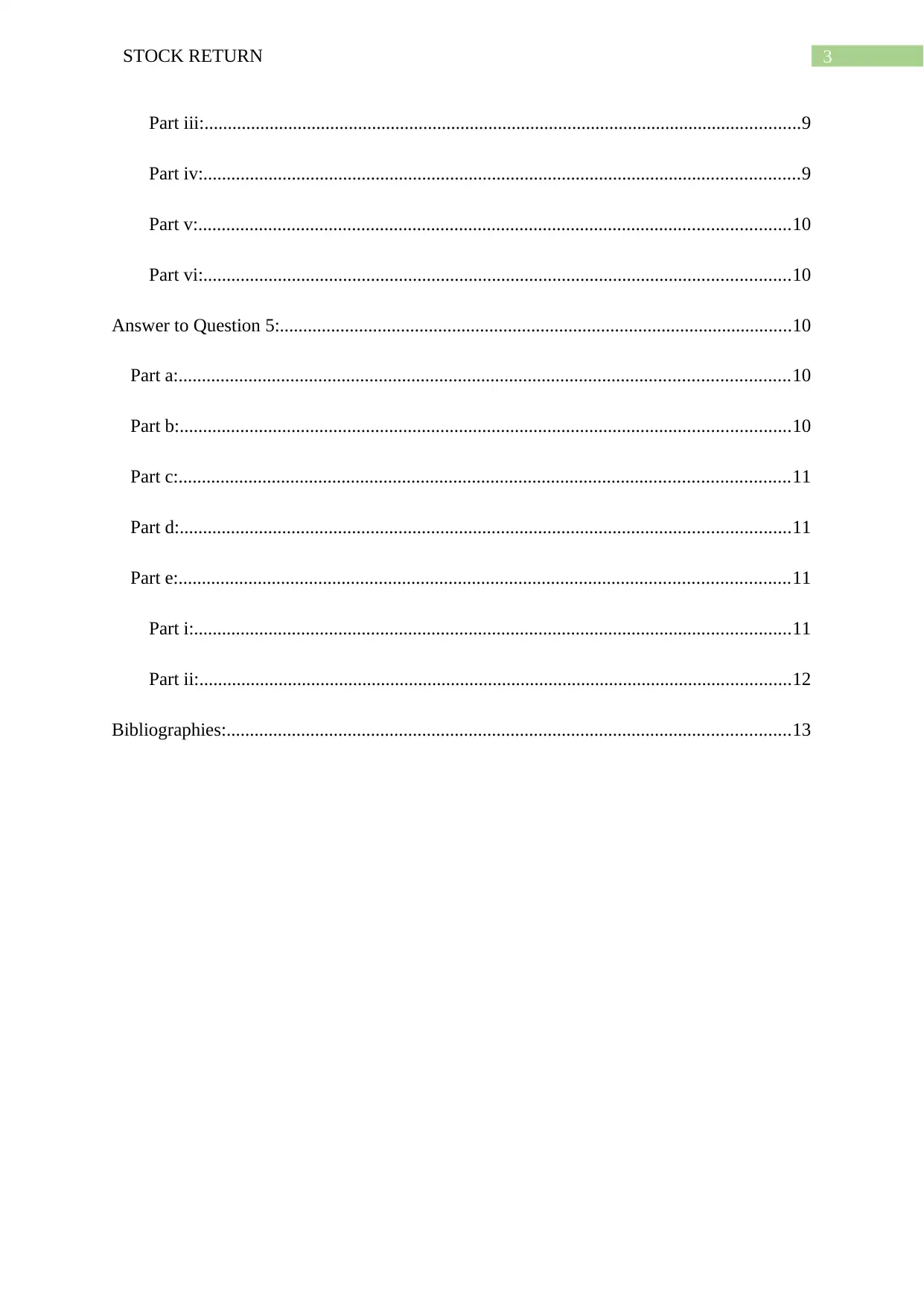
3STOCK RETURN
Part iii:................................................................................................................................9
Part iv:................................................................................................................................9
Part v:...............................................................................................................................10
Part vi:..............................................................................................................................10
Answer to Question 5:..............................................................................................................10
Part a:...................................................................................................................................10
Part b:...................................................................................................................................10
Part c:...................................................................................................................................11
Part d:...................................................................................................................................11
Part e:...................................................................................................................................11
Part i:................................................................................................................................11
Part ii:...............................................................................................................................12
Bibliographies:.........................................................................................................................13
Part iii:................................................................................................................................9
Part iv:................................................................................................................................9
Part v:...............................................................................................................................10
Part vi:..............................................................................................................................10
Answer to Question 5:..............................................................................................................10
Part a:...................................................................................................................................10
Part b:...................................................................................................................................10
Part c:...................................................................................................................................11
Part d:...................................................................................................................................11
Part e:...................................................................................................................................11
Part i:................................................................................................................................11
Part ii:...............................................................................................................................12
Bibliographies:.........................................................................................................................13
You're viewing a preview
Unlock full access by subscribing today!
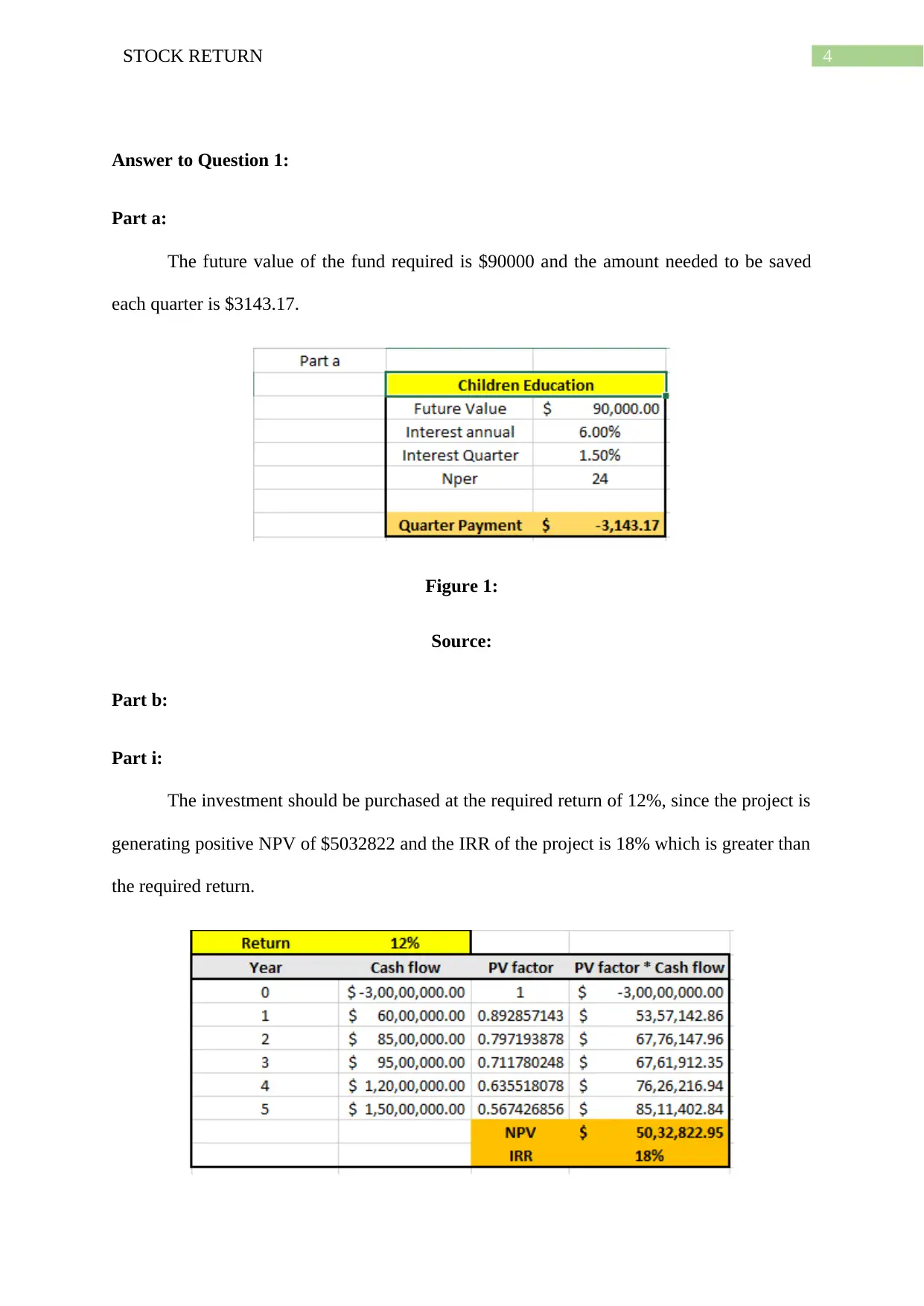
4STOCK RETURN
Answer to Question 1:
Part a:
The future value of the fund required is $90000 and the amount needed to be saved
each quarter is $3143.17.
Figure 1:
Source:
Part b:
Part i:
The investment should be purchased at the required return of 12%, since the project is
generating positive NPV of $5032822 and the IRR of the project is 18% which is greater than
the required return.
Answer to Question 1:
Part a:
The future value of the fund required is $90000 and the amount needed to be saved
each quarter is $3143.17.
Figure 1:
Source:
Part b:
Part i:
The investment should be purchased at the required return of 12%, since the project is
generating positive NPV of $5032822 and the IRR of the project is 18% which is greater than
the required return.
Paraphrase This Document
Need a fresh take? Get an instant paraphrase of this document with our AI Paraphraser
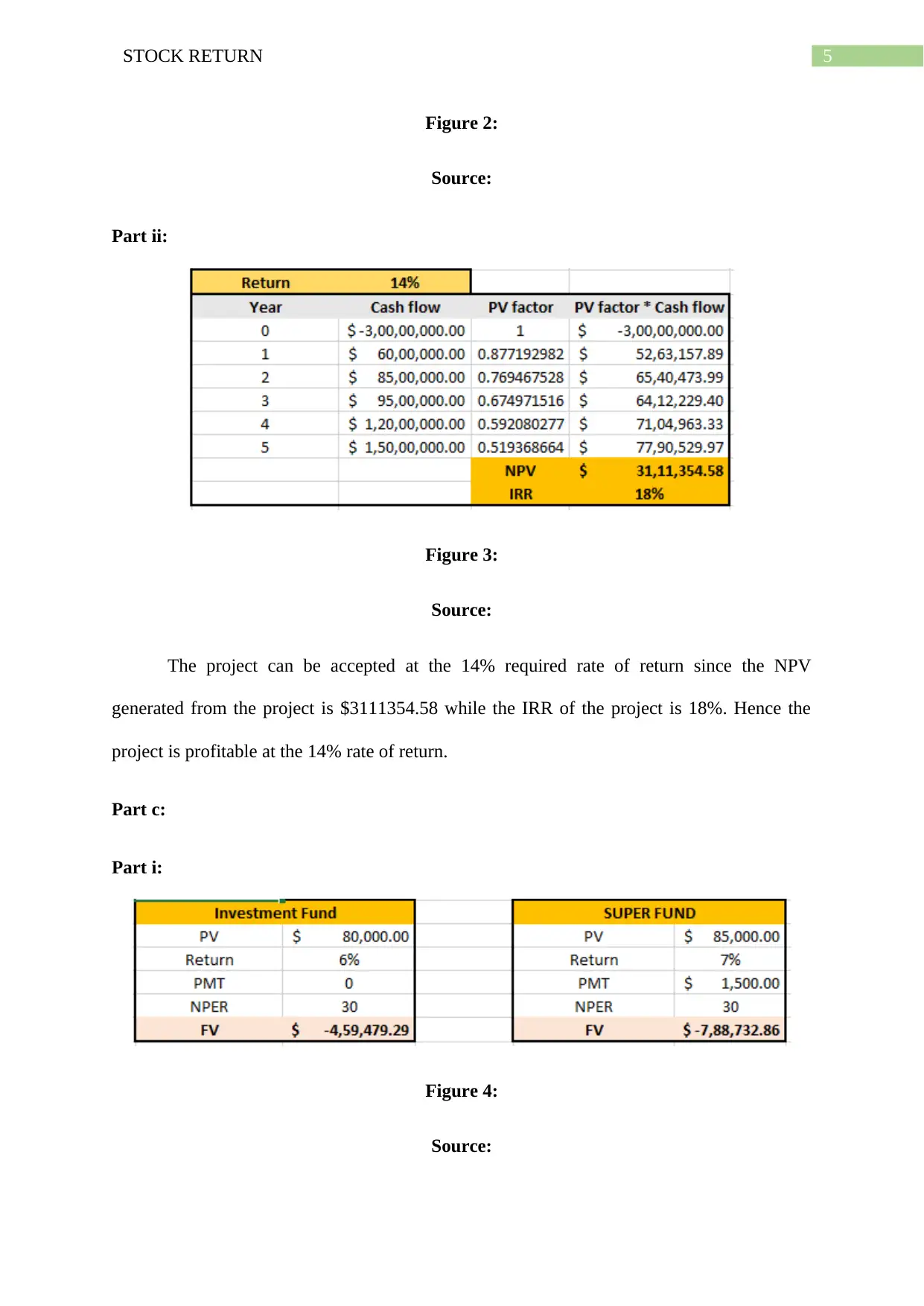
5STOCK RETURN
Figure 2:
Source:
Part ii:
Figure 3:
Source:
The project can be accepted at the 14% required rate of return since the NPV
generated from the project is $3111354.58 while the IRR of the project is 18%. Hence the
project is profitable at the 14% rate of return.
Part c:
Part i:
Figure 4:
Source:
Figure 2:
Source:
Part ii:
Figure 3:
Source:
The project can be accepted at the 14% required rate of return since the NPV
generated from the project is $3111354.58 while the IRR of the project is 18%. Hence the
project is profitable at the 14% rate of return.
Part c:
Part i:
Figure 4:
Source:
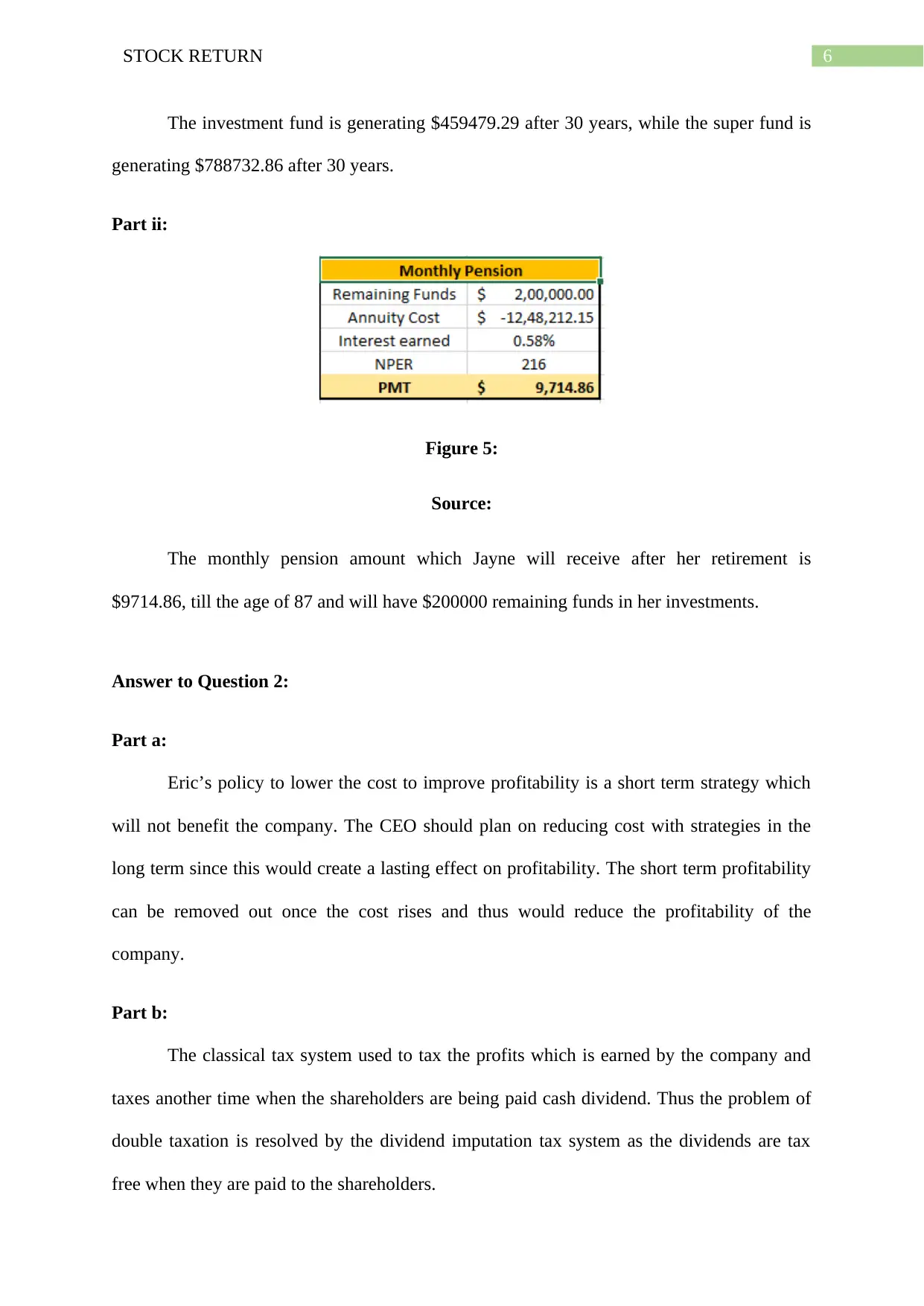
6STOCK RETURN
The investment fund is generating $459479.29 after 30 years, while the super fund is
generating $788732.86 after 30 years.
Part ii:
Figure 5:
Source:
The monthly pension amount which Jayne will receive after her retirement is
$9714.86, till the age of 87 and will have $200000 remaining funds in her investments.
Answer to Question 2:
Part a:
Eric’s policy to lower the cost to improve profitability is a short term strategy which
will not benefit the company. The CEO should plan on reducing cost with strategies in the
long term since this would create a lasting effect on profitability. The short term profitability
can be removed out once the cost rises and thus would reduce the profitability of the
company.
Part b:
The classical tax system used to tax the profits which is earned by the company and
taxes another time when the shareholders are being paid cash dividend. Thus the problem of
double taxation is resolved by the dividend imputation tax system as the dividends are tax
free when they are paid to the shareholders.
The investment fund is generating $459479.29 after 30 years, while the super fund is
generating $788732.86 after 30 years.
Part ii:
Figure 5:
Source:
The monthly pension amount which Jayne will receive after her retirement is
$9714.86, till the age of 87 and will have $200000 remaining funds in her investments.
Answer to Question 2:
Part a:
Eric’s policy to lower the cost to improve profitability is a short term strategy which
will not benefit the company. The CEO should plan on reducing cost with strategies in the
long term since this would create a lasting effect on profitability. The short term profitability
can be removed out once the cost rises and thus would reduce the profitability of the
company.
Part b:
The classical tax system used to tax the profits which is earned by the company and
taxes another time when the shareholders are being paid cash dividend. Thus the problem of
double taxation is resolved by the dividend imputation tax system as the dividends are tax
free when they are paid to the shareholders.
You're viewing a preview
Unlock full access by subscribing today!
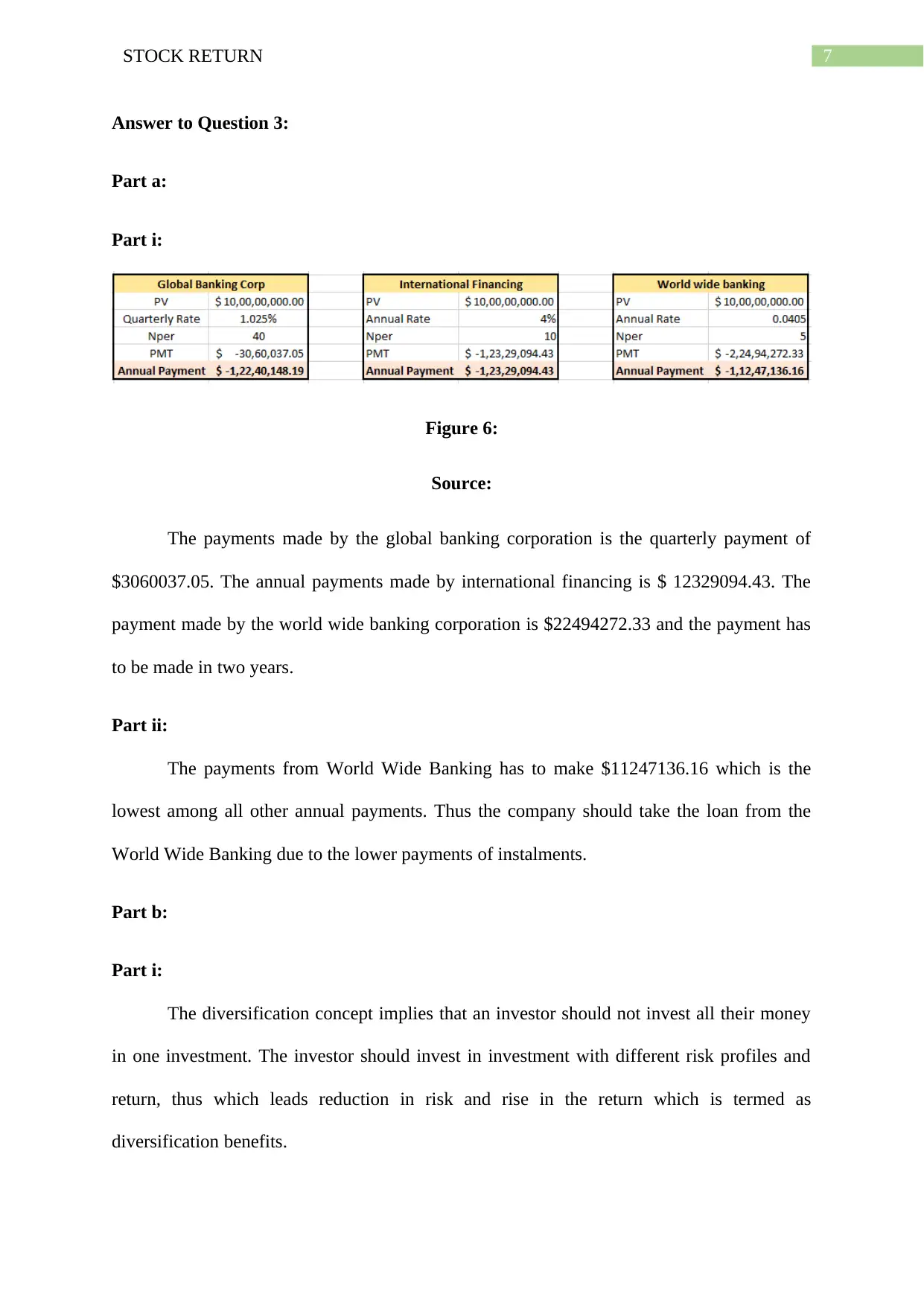
7STOCK RETURN
Answer to Question 3:
Part a:
Part i:
Figure 6:
Source:
The payments made by the global banking corporation is the quarterly payment of
$3060037.05. The annual payments made by international financing is $ 12329094.43. The
payment made by the world wide banking corporation is $22494272.33 and the payment has
to be made in two years.
Part ii:
The payments from World Wide Banking has to make $11247136.16 which is the
lowest among all other annual payments. Thus the company should take the loan from the
World Wide Banking due to the lower payments of instalments.
Part b:
Part i:
The diversification concept implies that an investor should not invest all their money
in one investment. The investor should invest in investment with different risk profiles and
return, thus which leads reduction in risk and rise in the return which is termed as
diversification benefits.
Answer to Question 3:
Part a:
Part i:
Figure 6:
Source:
The payments made by the global banking corporation is the quarterly payment of
$3060037.05. The annual payments made by international financing is $ 12329094.43. The
payment made by the world wide banking corporation is $22494272.33 and the payment has
to be made in two years.
Part ii:
The payments from World Wide Banking has to make $11247136.16 which is the
lowest among all other annual payments. Thus the company should take the loan from the
World Wide Banking due to the lower payments of instalments.
Part b:
Part i:
The diversification concept implies that an investor should not invest all their money
in one investment. The investor should invest in investment with different risk profiles and
return, thus which leads reduction in risk and rise in the return which is termed as
diversification benefits.
Paraphrase This Document
Need a fresh take? Get an instant paraphrase of this document with our AI Paraphraser
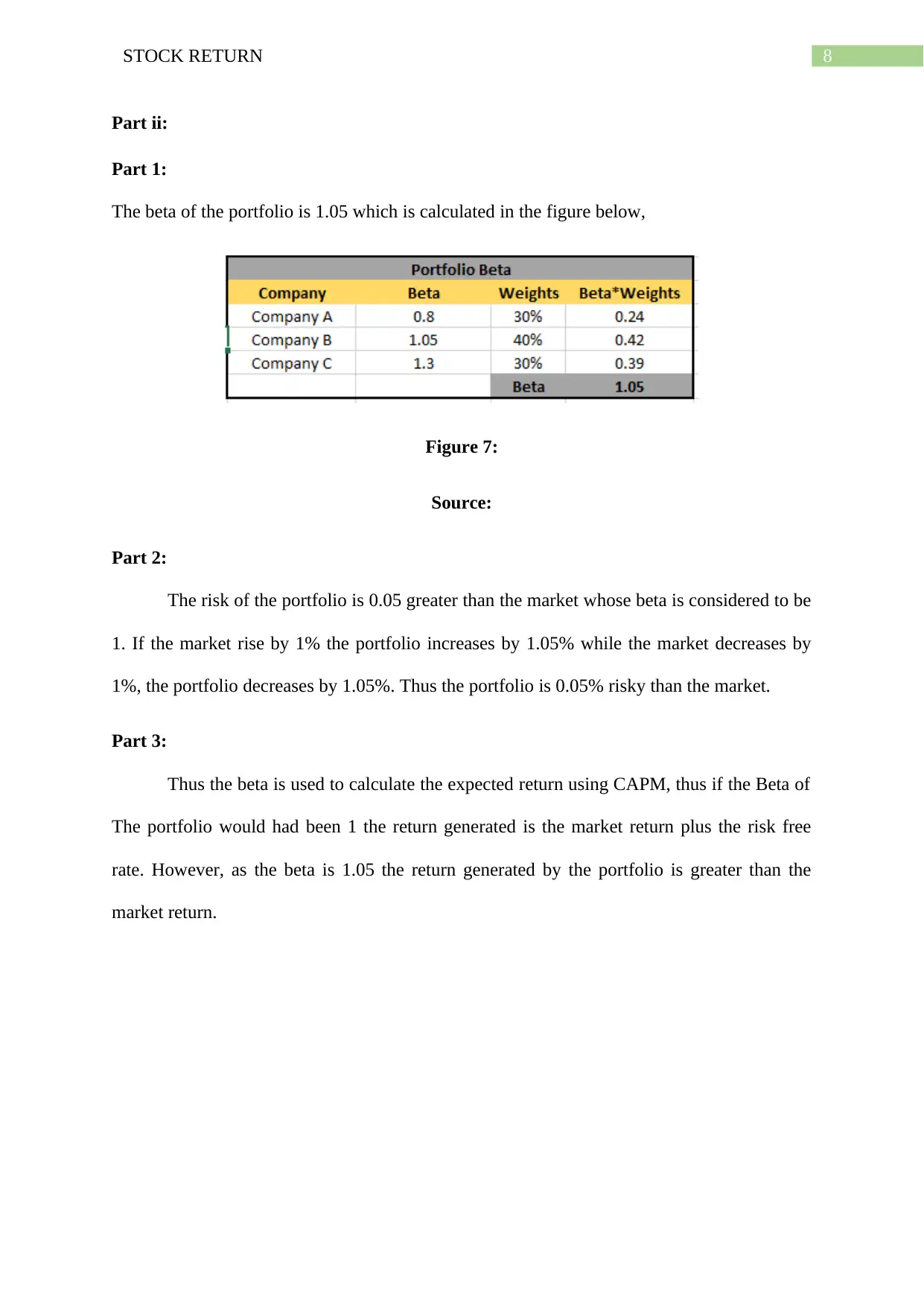
8STOCK RETURN
Part ii:
Part 1:
The beta of the portfolio is 1.05 which is calculated in the figure below,
Figure 7:
Source:
Part 2:
The risk of the portfolio is 0.05 greater than the market whose beta is considered to be
1. If the market rise by 1% the portfolio increases by 1.05% while the market decreases by
1%, the portfolio decreases by 1.05%. Thus the portfolio is 0.05% risky than the market.
Part 3:
Thus the beta is used to calculate the expected return using CAPM, thus if the Beta of
The portfolio would had been 1 the return generated is the market return plus the risk free
rate. However, as the beta is 1.05 the return generated by the portfolio is greater than the
market return.
Part ii:
Part 1:
The beta of the portfolio is 1.05 which is calculated in the figure below,
Figure 7:
Source:
Part 2:
The risk of the portfolio is 0.05 greater than the market whose beta is considered to be
1. If the market rise by 1% the portfolio increases by 1.05% while the market decreases by
1%, the portfolio decreases by 1.05%. Thus the portfolio is 0.05% risky than the market.
Part 3:
Thus the beta is used to calculate the expected return using CAPM, thus if the Beta of
The portfolio would had been 1 the return generated is the market return plus the risk free
rate. However, as the beta is 1.05 the return generated by the portfolio is greater than the
market return.
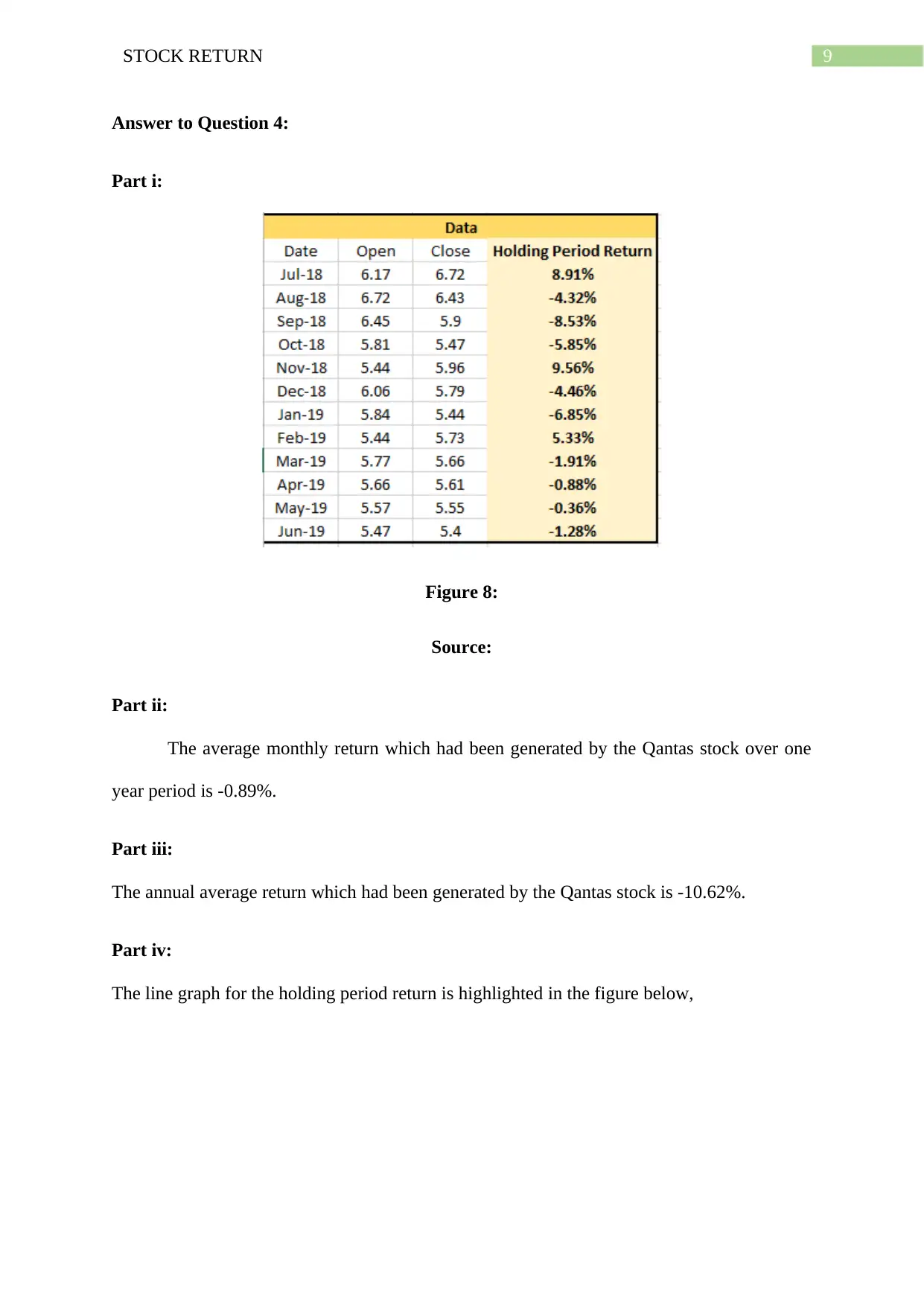
9STOCK RETURN
Answer to Question 4:
Part i:
Figure 8:
Source:
Part ii:
The average monthly return which had been generated by the Qantas stock over one
year period is -0.89%.
Part iii:
The annual average return which had been generated by the Qantas stock is -10.62%.
Part iv:
The line graph for the holding period return is highlighted in the figure below,
Answer to Question 4:
Part i:
Figure 8:
Source:
Part ii:
The average monthly return which had been generated by the Qantas stock over one
year period is -0.89%.
Part iii:
The annual average return which had been generated by the Qantas stock is -10.62%.
Part iv:
The line graph for the holding period return is highlighted in the figure below,
You're viewing a preview
Unlock full access by subscribing today!
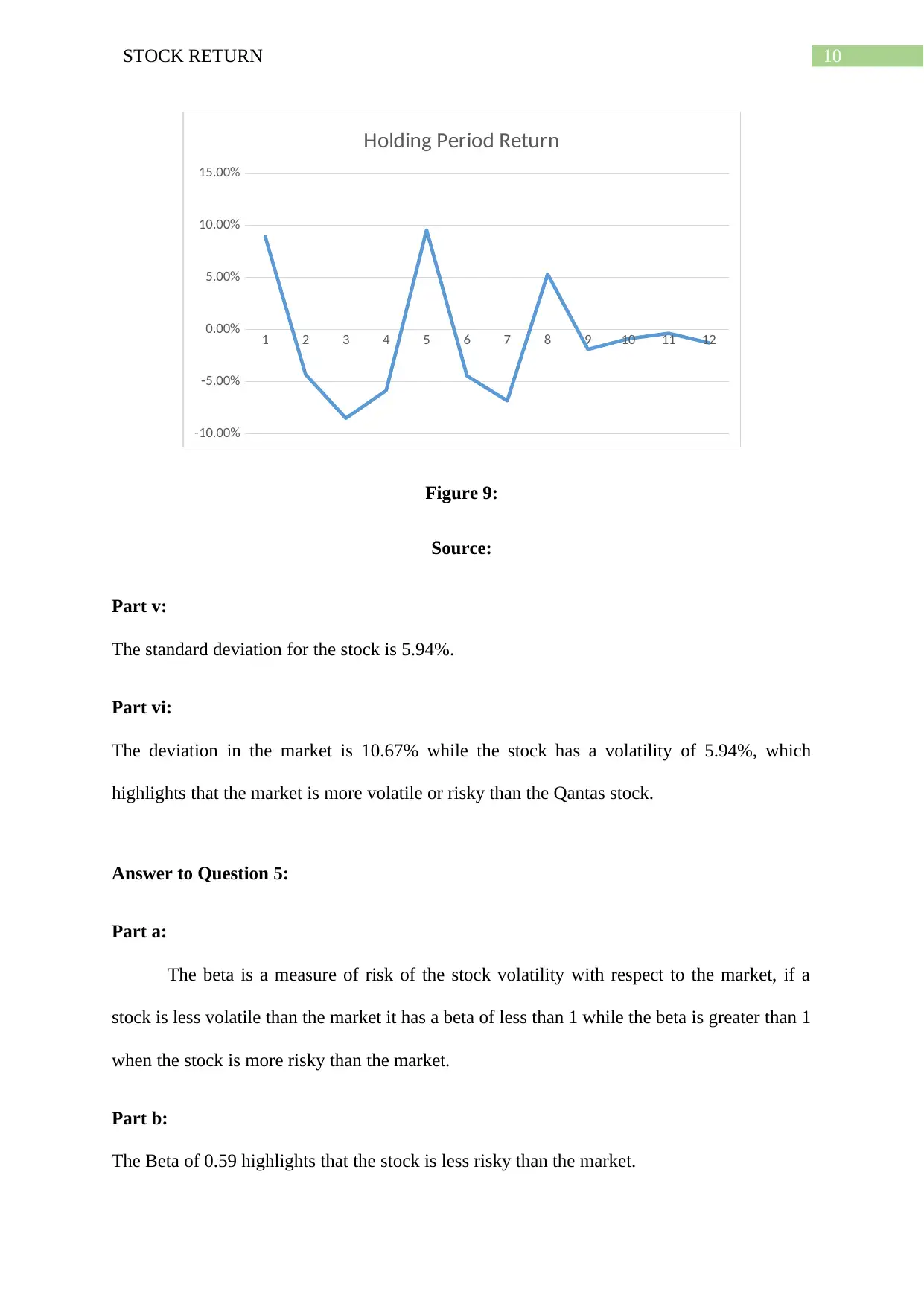
10STOCK RETURN
1 2 3 4 5 6 7 8 9 10 11 12
-10.00%
-5.00%
0.00%
5.00%
10.00%
15.00%
Holding Period Return
Figure 9:
Source:
Part v:
The standard deviation for the stock is 5.94%.
Part vi:
The deviation in the market is 10.67% while the stock has a volatility of 5.94%, which
highlights that the market is more volatile or risky than the Qantas stock.
Answer to Question 5:
Part a:
The beta is a measure of risk of the stock volatility with respect to the market, if a
stock is less volatile than the market it has a beta of less than 1 while the beta is greater than 1
when the stock is more risky than the market.
Part b:
The Beta of 0.59 highlights that the stock is less risky than the market.
1 2 3 4 5 6 7 8 9 10 11 12
-10.00%
-5.00%
0.00%
5.00%
10.00%
15.00%
Holding Period Return
Figure 9:
Source:
Part v:
The standard deviation for the stock is 5.94%.
Part vi:
The deviation in the market is 10.67% while the stock has a volatility of 5.94%, which
highlights that the market is more volatile or risky than the Qantas stock.
Answer to Question 5:
Part a:
The beta is a measure of risk of the stock volatility with respect to the market, if a
stock is less volatile than the market it has a beta of less than 1 while the beta is greater than 1
when the stock is more risky than the market.
Part b:
The Beta of 0.59 highlights that the stock is less risky than the market.
Paraphrase This Document
Need a fresh take? Get an instant paraphrase of this document with our AI Paraphraser
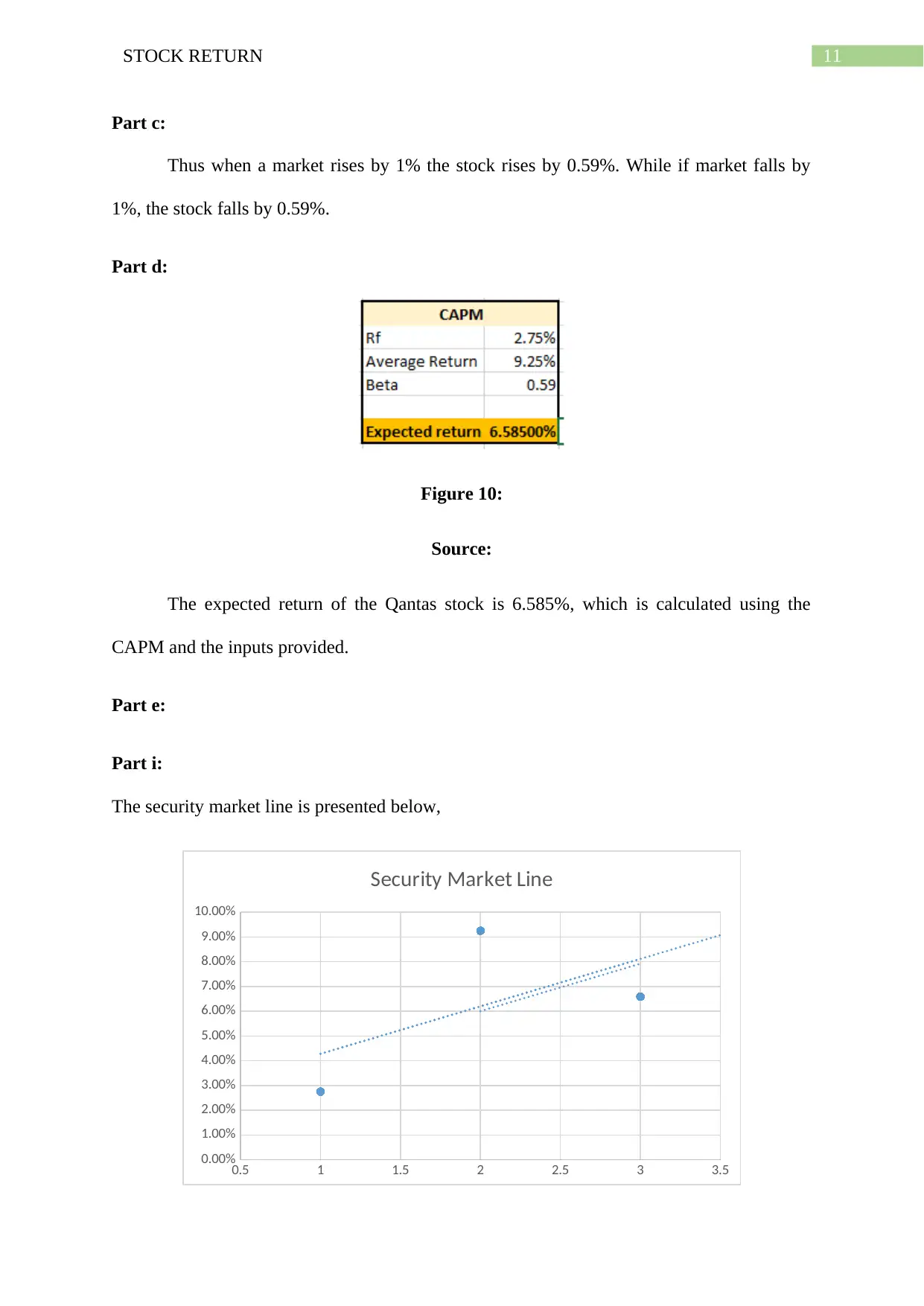
11STOCK RETURN
Part c:
Thus when a market rises by 1% the stock rises by 0.59%. While if market falls by
1%, the stock falls by 0.59%.
Part d:
Figure 10:
Source:
The expected return of the Qantas stock is 6.585%, which is calculated using the
CAPM and the inputs provided.
Part e:
Part i:
The security market line is presented below,
0.5 1 1.5 2 2.5 3 3.5
0.00%
1.00%
2.00%
3.00%
4.00%
5.00%
6.00%
7.00%
8.00%
9.00%
10.00%
Security Market Line
Part c:
Thus when a market rises by 1% the stock rises by 0.59%. While if market falls by
1%, the stock falls by 0.59%.
Part d:
Figure 10:
Source:
The expected return of the Qantas stock is 6.585%, which is calculated using the
CAPM and the inputs provided.
Part e:
Part i:
The security market line is presented below,
0.5 1 1.5 2 2.5 3 3.5
0.00%
1.00%
2.00%
3.00%
4.00%
5.00%
6.00%
7.00%
8.00%
9.00%
10.00%
Security Market Line
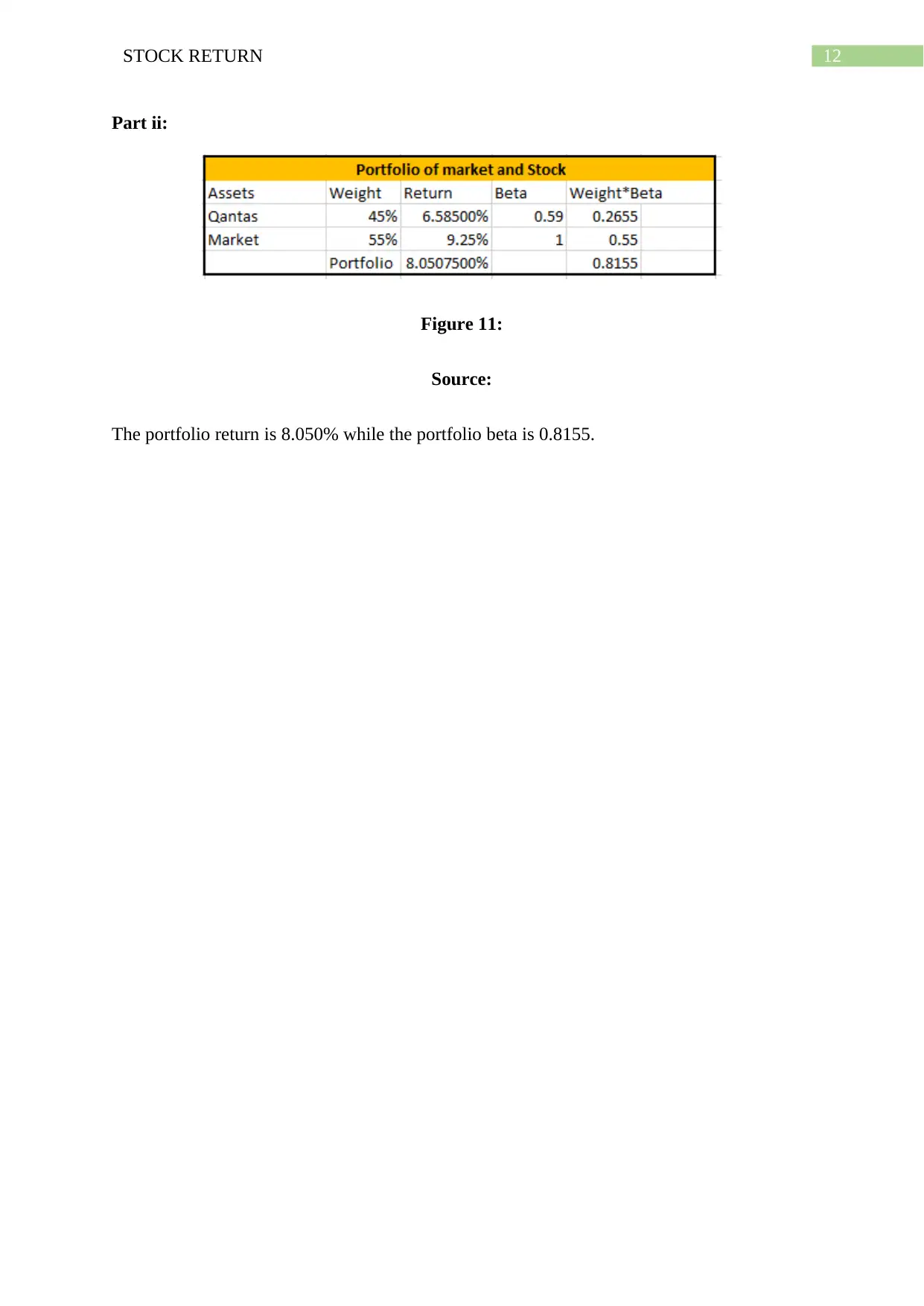
12STOCK RETURN
Part ii:
Figure 11:
Source:
The portfolio return is 8.050% while the portfolio beta is 0.8155.
Part ii:
Figure 11:
Source:
The portfolio return is 8.050% while the portfolio beta is 0.8155.
You're viewing a preview
Unlock full access by subscribing today!
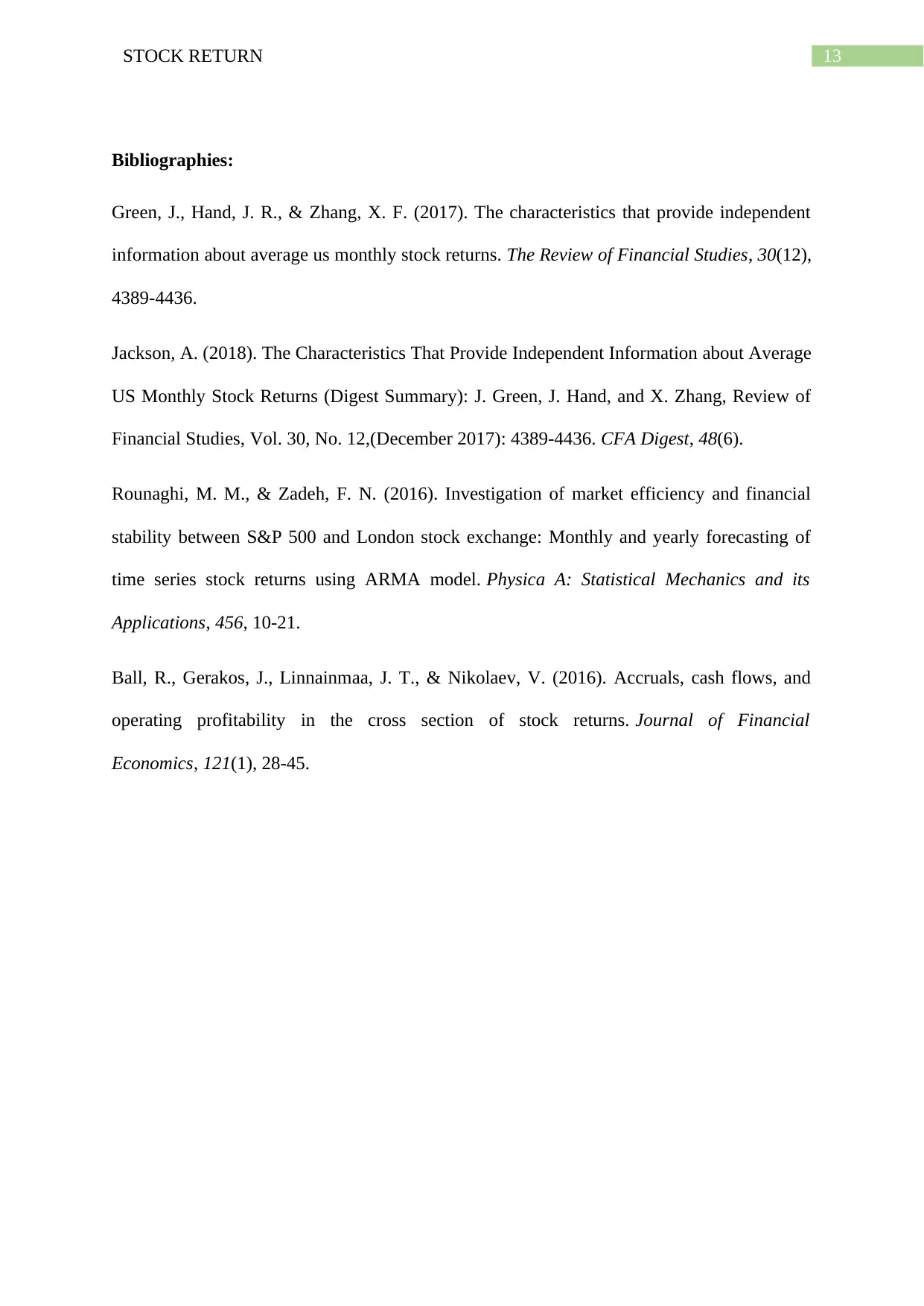
13STOCK RETURN
Bibliographies:
Green, J., Hand, J. R., & Zhang, X. F. (2017). The characteristics that provide independent
information about average us monthly stock returns. The Review of Financial Studies, 30(12),
4389-4436.
Jackson, A. (2018). The Characteristics That Provide Independent Information about Average
US Monthly Stock Returns (Digest Summary): J. Green, J. Hand, and X. Zhang, Review of
Financial Studies, Vol. 30, No. 12,(December 2017): 4389-4436. CFA Digest, 48(6).
Rounaghi, M. M., & Zadeh, F. N. (2016). Investigation of market efficiency and financial
stability between S&P 500 and London stock exchange: Monthly and yearly forecasting of
time series stock returns using ARMA model. Physica A: Statistical Mechanics and its
Applications, 456, 10-21.
Ball, R., Gerakos, J., Linnainmaa, J. T., & Nikolaev, V. (2016). Accruals, cash flows, and
operating profitability in the cross section of stock returns. Journal of Financial
Economics, 121(1), 28-45.
Bibliographies:
Green, J., Hand, J. R., & Zhang, X. F. (2017). The characteristics that provide independent
information about average us monthly stock returns. The Review of Financial Studies, 30(12),
4389-4436.
Jackson, A. (2018). The Characteristics That Provide Independent Information about Average
US Monthly Stock Returns (Digest Summary): J. Green, J. Hand, and X. Zhang, Review of
Financial Studies, Vol. 30, No. 12,(December 2017): 4389-4436. CFA Digest, 48(6).
Rounaghi, M. M., & Zadeh, F. N. (2016). Investigation of market efficiency and financial
stability between S&P 500 and London stock exchange: Monthly and yearly forecasting of
time series stock returns using ARMA model. Physica A: Statistical Mechanics and its
Applications, 456, 10-21.
Ball, R., Gerakos, J., Linnainmaa, J. T., & Nikolaev, V. (2016). Accruals, cash flows, and
operating profitability in the cross section of stock returns. Journal of Financial
Economics, 121(1), 28-45.
1 out of 13
Related Documents
Your All-in-One AI-Powered Toolkit for Academic Success.
+13062052269
info@desklib.com
Available 24*7 on WhatsApp / Email
![[object Object]](/_next/static/media/star-bottom.7253800d.svg)
Unlock your academic potential
© 2024 | Zucol Services PVT LTD | All rights reserved.




